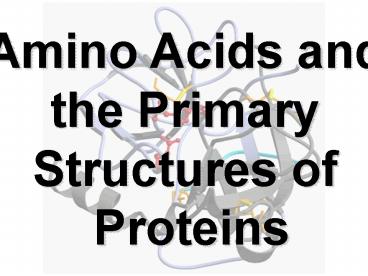Amino Acids and - PowerPoint PPT Presentation
1 / 59
Title: Amino Acids and
1
Amino Acids and the PrimaryStructures of
Proteins
2
- Firefly Luciferase and Luciferin
3
- Hemoglobin in erythrocytes
4
Keratin
5
Chemical structure ofan amino acid R side
chain
Carboxyl terminus
C alpha carbon
Amino terminus
R side chain
6
The alpha carbon of amino acids is chiral (except
glycine). There are two stereoisomers of amino
acids (L and D). Proteins contain L-amino acids
7
L-amino acidat neutral pH Figure 3.1
8
Amino acids with aliphatic R groups
9
Amino acids with aliphatic R groups
10
The amino acid proline is a cyclic molecule
11
Amino acids with aromatic R groups
12
Amino acids with sulfur-containing R groups
13
Oxidation can form cystine from two
cysteines Figure 3.4
14
Side chains with alcohol groups
15
Amino acids with basic R groups
16
Amino acids with acidic R groups
17
Amide derivatives of acidic R groups
18
Other amino acids and amino acid
derivatives Figure 3.5
19
Selenocysteine is the 21st amino acid
20
Ionization of amino acids Pages 60 64
pH ?
pH ?
21
Ionization of amino acids Pages 60 64
pH 1
pH 7
22
Ionization of amino acids Pages 60 64
pH ?
pH 7
23
Ionization of amino acids Pages 60 64
pH 12
pH 7
24
(No Transcript)
25
Ionization of histidine Figure 3.7
26
Ionization of histidine Figure 3.7
27
(No Transcript)
28
Ionization of glutamate Figure 3.8
29
Ionization of arginine Figure 3.8
30
Peptide bonds link amino acids in
proteins Figure 3.9
31
Peptide bonds link amino acids in
proteins Figure 3.9
Alanine Ala (A)
Serine Ser (S)
DipeptideAla Ser or AS
32
Practice Problem Draw the chemical structure of
the tripeptide Ala Ser Cys at pH 7.
Answer the following with regard to this
tripeptide 1. Indicate the charge present on
any ionizable group(s). 2. Indicate, using an
arrow, which covalent bond is the peptide bond.
3. What is the net, overall charge of this
tripeptide at pH 7? __________ 4. What is this
peptide called using the one-letter code system
for amino acids? ______
33
Proteins can be very large, hundreds of amino
acids long
The enzyme HMG-CoA reductase MLSRLFRMHGLFVASHPWEV
IVGTVTLTICMMSMNMFTGNNKICGWNYECPKFEEDVLSSDIIILTITRC
IAILYIYFQFQNLRQLGSKYILGIAGLFTIFSSFVFSTVVIHFLDKELTG
LNEALPFFLLLIDLSRASTLAKFALSSNSQDEVRENIARGMAILGPTFTL
DALVECLVIGVGTMSGVRQLEIMCCFGCMSVLANYFVFMTFFPACVSLVL
ELSRESREGRPIWQLSHFARVLEEEENKPNPVTQRVKMIMSLGLVLVHAH
SRWIADPSPQNSTADTSKVSLGLDENVSKRIEPSVSLWQFYLSKMISMDI
EQVITLSLALLLAVKYIFFEQTETESTLSLKNPITSPVVTQKKVPDNCCR
REPMLVRNNQKCDSVEEETGINRERKVEVIKPLVAETDTPNRATFVVGNS
SLLDTSSVLVTQEPEIELPREPRPNEECLQILGNAEKGAKFLSDAEIIQL
VNAKHIPAYKLETLMETHERGVSIRRQLLSKKLSEPSSLQYLPYRDYNYS
LVMGACCENVIGYMPIPVGVAGPLCLDEKEFQVPMATTEGCLVASTNRGC
RAIGLGGGASSRVLADGMTRGPVVRLPRACDSAEVKAWLETSEGFAVIKE
AFDSTSRFARLQKLHTSIAGRNLYIRFQSRSGDAMGMNMISKGTEKALSK
LHEYFPEMQILAVSGNYCTDKKPAAINWIEGRGKSVVCEAVIPAKVVREV
LKTTTEAMIEVNINKNLVGSAMAGSIGGYNAHAANIVTAIYIACGQDAAQ
NVGSSNCITLMEASGPTNEDLYISCTMPSIEIGTVGGGTNLLPQQACLQM
LGVQGACKDNPGENARQLARIVCGTVMAGELSLMAALAAGHLVKSHMIHN
RSKINLQDLQGACTKKTA
34
Protein Purification Techniques
In order to study a protein, it must be
separated from other proteins
- Methods of separating proteins
- Fractionation by varying solubility.
- Example ammonium sulfate precipitation
- Column chromatography to exploit binding
properties. - Example ion-exchange chromatography
- Electrophoresis, separation in an electric field.
- Example SDS-PAGE
35
Fractionation by relative solubility
The procedure of ammonium sulfate (AS)
precipitation is used to separate proteins on
the basis of their relative solubilities. The
solubility of proteins is lowered at higher salt
concentrations This is called salting out. As the
amount of AS is increased, more proteins
precipitate. A protein chemist wants to determine
where the protein of interest precipitates and
other proteins do not (or vice-versa).
36
Columnchromatography Figure 3.11
37
Ion Exchange Chromatography
38
Size-exclusion Chromatography
39
Affinity Chromatography
40
Chemical structure ofan amino acid R side
chain
Carboxyl terminus
C alpha carbon
Amino terminus
R side chain
41
Peptide bonds link amino acids in
proteins Figure 3.9
Alanine Ala (A)
Serine Ser (S)
DipeptideAla Ser or AS
42
Protein Purification Techniques
In order to study a protein, it must be
separated from other proteins
- Methods of separating proteins
- Fractionation by varying solubility.
- Example ammonium sulfate precipitation
- Column chromatography to exploit binding
properties. - Example ion-exchange chromatography
- Electrophoresis, separation in an electric field.
- Example SDS-PAGE
43
SDS-PolyAcrylamide Gel Electrophoresis (SDS-PAGE)
Figure 3.12
44
SDS binds to protein molecules. One SDS per two
amino acids
45
(No Transcript)
46
Determining the identity of amino acids in a
protein.Determining the sequence ofamino acid
residues in a protein.
47
Problem We have purified insulin, a small
protein. We want to know the sequence. Determine
amino acid composition. Hydrolyze with 6 M
HCl. Analyze by HPLC. This is called amino acid
analysis. It tells us the amount of each amino
acidin the protein, but not the order.
48
Acid-catalyzed hydrolysis of a peptide Figure
3.13
49
Separation of amino acids by HPLC, a column
chromatography method Figure 3.15
50
Determining the sequence ofamino acid residues
in a protein.Edman degradation
51
Proteins can be sequencedusing a process
calledEdman degradation. First, however, the
disulfide bonds mustbe broken.
52
Treatment of a protein with 2-mercaptoethanolredu
ces disulfide bonds Figure 3.17
53
Proteins can be sequencedusing a process
calledEdman degradation. First, however, the
disulfide bonds mustbe broken. Next, one amino
acid at a time is removed from the amino
terminus and identified.
54
Problem Only about 50 amino acidscan be
accurately sequenced inone round ofEdman
degradation. The protein must be cleaved into
smallerfragments (peptides) and sequenced
individually.
55
Treatment of a protein with cyanogen
bromidecleaves peptide bonds at the
carboxy-terminal side of methionine
residues Figure 3.18
56
Treatment of a protein with the enzyme
trypsincleaves peptide bonds at the
carboxy-terminal side of arginine and lysine
residues. Figure 3.19
57
Treatment of a protein with the enzyme
chymotrypsincleaves peptide bonds at the
carboxy-terminal side of phenylalanine,
tyrosine, and tryptophan residues. Figure 3.19
58
Cleavage of a protein with trypsin and
chymotrypsinproduces overlapping peptide
fragments. Figure 3.19
59
NextChapter 4Proteins Three-DimensionalStru
cture and Function































